

Fertile Crescent. Fertile Crescent - What Is the Fertile Crescent. Definition: The "fertile crescent" refers to an ancient area of fertile soil and important rivers stretching in an arc from the Nile to the Tigris and Euphrates.
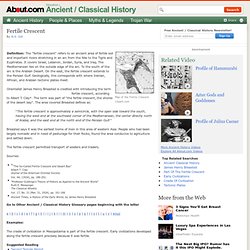
It covers Israel, Lebanon, Jordan, Syria, and Iraq. Mesopotamia. Map showing the extent of Mesopotamia Mesopotamia (from the Ancient Greek: Μεσοποταμία: "[land] between rivers"; Arabic: بلاد الرافدين (bilād al-rāfidayn); Syriac: ܒܝܬ ܢܗܪܝܢ (Beth Nahrain): "land of rivers") is a name for the area of the Tigris–Euphrates river system, corresponding to modern-day Iraq, Kuwait, the northeastern section of Syria and to a much lesser extent southeastern Turkey and smaller parts of southwestern Iran.

Euphrates. Tigris. The Tigris River /ˈtaɪɡrɪs/ is the eastern member of the two great rivers that define Mesopotamia, the other being the Euphrates.
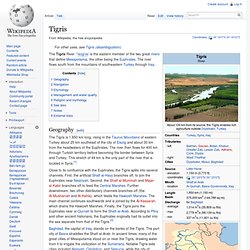
Sumer. The irrigated farming together with annual replenishment of soil fertility and the surplus of storable food in temple granaries created by this economy allowed the population of this region to rise to levels never before seen, unlike those found in earlier cultures of shifting cultivators.
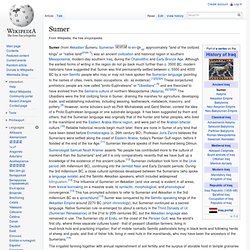
This much greater population density in turn created and required an extensive labour force and division of labour with many specialised arts and crafts. Babylonia. Babylonia was an ancient Akkadian-speaking Semitic nation state and cultural region based in central-southern Mesopotamia (present-day Iraq).

It emerged as an independent state c. 1894 BC, with the city of Babylon as its capital. It was often involved in rivalry with its fellow Akkadian state of Assyria in northern Mesopotamia. Babylonia became the major power in the region after Hammurabi (fl. c. 1792 - 1752 BC middle chronology, or c. 1696 – 1654 BC, short chronology) created an empire out of many of the territories of the former Akkadian Empire.
The Babylonian state retained the written Semitic Akkadian language for official use (the language of its native populace), despite its Amorite founders and Kassite successors not being native Akkadians. It retained the Sumerian language for religious use, but by the time Babylon was founded this was no longer a spoken language, having been wholly subsumed by Akkadian. Periods[edit] Old Pre-Babylonian period[edit] Achaemenid Empire. The Achaemenid Empire (/əˈkiːmənɪd/; Old Persian: Pārsa;[9][10] New Persian: شاهنشاهی هخامنشی c. 550–330 BC), or First Persian Empire,[11] was an empire in Western and Central Asia, founded in the 6th century BC by Cyrus the Great.[11] The dynasty draws its name from king Achaemenes, who ruled Persis between 705 BC and 675 BC.
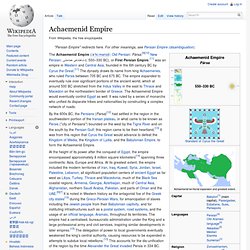
The empire expanded to eventually rule over significant portions of the ancient world, which at around 500 BC stretched from the Indus Valley in the east to Thrace and Macedon on the northeastern border of Greece. The Achaemenid Empire would eventually control Egypt as well. It was ruled by a series of monarchs who unified its disparate tribes and nationalities by constructing a complex network of roads.
The historical mark of the Achaemenid Empire went far beyond its territorial and military influences and included cultural, social, technological and religious influences as well. History[edit] Achaemenid Timeline[edit] Astronomical year numbering Origin[edit] History of the Hittites. The Hittites were an ancient Anatolian people who established an empire at Hattusa in north-central Anatolia around 1600 BC. This empire reached its height during the mid-14th century BC under Suppiluliuma I, when it encompassed an area that included most of Asia Minor as well as parts of the northern Levant and Upper Mesopotamia.
After c. 1180 BC, the empire came to an end during the Bronze Age collapse, splintering into several independent "Neo-Hittite" city-states, some of which survived until the 8th century BC. The Hittite language was a member of the Anatolian branch of the Indo-European language family. They referred to their native land as Hatti. The conventional name "Hittites" is due to their initial identification with the Biblical Hittites in 19th century archaeology. Archaeological discovery[edit] The Hittites used Mesopotamian cuneiform letters. Nile. The Nile (Arabic: النيل, Eg. en-Nīl, Std. an-Nīl; Coptic: ⲫⲓⲁⲣⲱ, P(h)iaro; Ancient Egyptian: Ḥ'pī and Iteru) is a major north-flowing river in northeastern Africa, generally regarded as the longest river in the world.[2] It is 6,853 km (4,258 miles) long.
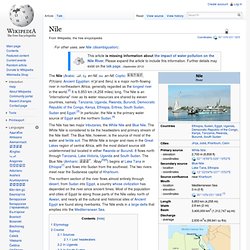
The Nile is an "international" river as its water resources are shared by eleven countries, namely, Tanzania, Uganda, Rwanda, Burundi, Democratic Republic of the Congo, Kenya, Ethiopia, Eritrea, South Sudan, Sudan and Egypt.[3] In particular, the Nile is the primary water source of Egypt and the northern Sudan.[4] Ancient Egypt. Ancient Egypt was an ancient civilization of Northeastern Africa, concentrated along the lower reaches of the Nile River in what is now the modern country of Egypt.

It is one of six civilizations globally to arise independently. Egyptian civilization coalesced around 3150 BC (according to conventional Egyptian chronology)[1] with the political unification of Upper and Lower Egypt under the first pharaoh.[2] The history of ancient Egypt occurred in a series of stable Kingdoms, separated by periods of relative instability known as Intermediate Periods: the Old Kingdom of the Early Bronze Age, the Middle Kingdom of the Middle Bronze Age and the New Kingdom of the Late Bronze Age. History Map of ancient Egypt, showing major cities and sites of the Dynastic period (c. 3150 BC to 30 BC) Predynastic period A typical Naqada II jar decorated with gazelles. In Predynastic and Early Dynastic times, the Egyptian climate was much less arid than it is today.
Early Dynastic Period (c. 3050 –2686 BC)